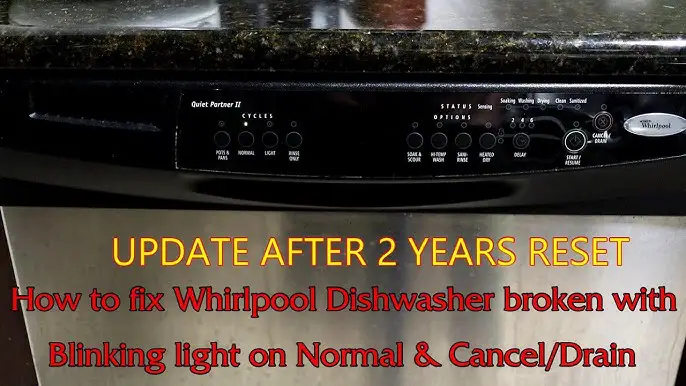You’re Troubleshooting the Heating Element of a Dishwasher: Expert Tips
You’re troubleshooting the heating element of a dishwasher, and let’s be honest—it can feel a little overwhelming. Is your dishwasher leaving dishes wet and lukewarm no matter how many cycles you run?
You’re not alone. A faulty heating element is a common problem, and fixing it doesn’t have to be a mystery. In this guide, we’ll walk you through the signs, causes, and steps to troubleshoot the issue. By the end, you’ll feel more confident diagnosing the problem and deciding if it’s a quick fix or time to call in a pro.
Stick around—you might just save yourself the cost of a new dishwasher!
Common Signs Of A Faulty Heating Element
A dishwasher’s heating element plays a crucial role in its performance. It helps to dry dishes and maintain water temperature during cycles. When the heating element fails, it impacts the dishwasher’s efficiency. Recognizing the signs of a faulty heating element can save time and repair costs.
Below are the most common symptoms of a malfunctioning heating element. Identifying these signs early can prevent further issues.
Dishes Are Still Wet After A Cycle
If dishes remain wet at the end of a cleaning cycle, the heating element might not be working. The dishwasher relies on heat to dry dishes properly. A faulty element disrupts this process, leaving dishes damp.
Water Doesn’t Get Hot Enough
A malfunctioning heating element can prevent water from reaching the required temperature. Cold or lukewarm water can reduce cleaning effectiveness. This results in food particles or grease left on dishes after washing.
Error Codes Displayed On The Control Panel
Many modern dishwashers have error codes to signal issues. A faulty heating element may trigger specific codes related to heating problems. Consult your dishwasher’s manual to confirm if the code refers to heating.
Burning Smell During Operation
A burning smell could indicate an overheated or damaged heating element. This issue may occur due to electrical faults or wear and tear. Ignoring the smell could worsen the problem or pose safety risks.

Credit: www.youtube.com
Essential Tools For The Job
Fixing the heating element of a dishwasher might sound intimidating, but with the right tools, it’s a task you can tackle confidently. Having the proper equipment ensures you work safely and efficiently. So, what should you have on hand before diving into troubleshooting? Let’s break it down.
Multimeter
A multimeter is your best friend when testing electrical components like the heating element. It helps you measure resistance and ensure the element is functioning correctly.
If you don’t own one, consider borrowing or purchasing it—it’s a tool that pays off, especially for DIY repairs.
Screwdrivers (phillips And Flathead)
You’ll need screwdrivers to access and remove the heating element or its protective cover inside the dishwasher.
Keep both Phillips and flathead types handy, as dishwashers often use a mix of screws.
Ever been stuck with the wrong screwdriver? It’s frustrating, and it slows you down. Avoid that by prepping ahead.
Needle-nose Pliers
When disconnecting wires or pulling out small components, needle-nose pliers come to the rescue. Their slim design makes them perfect for tight spaces.
A tip: check if the pliers have insulated handles to protect against accidental electrical shocks.
Insulated Gloves
Safety first! Insulated gloves protect your hands from electric shocks, especially when working with live wires.
Don’t risk it—using gloves is a simple yet crucial step to keeping you safe.
Flashlight Or Headlamp
Dishwasher interiors can be dark and cramped. A flashlight or headlamp ensures you see clearly while working.
If you’ve ever struggled to locate a screw in dim lighting, you know how important this tool is.
Owner’s Manual
Your dishwasher’s owner manual contains vital diagrams and troubleshooting steps specific to your model. It’s like having a cheat sheet right in front of you.
Take a moment to locate it before starting. If it’s lost, search online—most manufacturers provide digital copies.
Cleaning Supplies
Before accessing the heating element, you might need to clean away grime or debris. A cloth, some mild detergent, and a brush can make the job easier.
Don’t skip this step. A clean workspace improves visibility and prevents dirt from interfering with the repair.
These tools aren’t just helpful—they’re essential for a smooth repair process. Missing one can turn a simple fix into a frustrating ordeal. So, are you ready to gather your toolkit and get started?
Safety Precautions To Follow
Before diving into troubleshooting the heating element of your dishwasher, safety should be your first priority. Electrical components can be dangerous if handled incorrectly, and water adds an extra layer of risk. Taking the right precautions ensures you stay safe while working on your appliance.
1. Turn Off Power To The Dishwasher
Always disconnect your dishwasher from the power source before you begin. This is non-negotiable. Unplug it from the wall outlet or switch off the circuit breaker that powers it.
If you’re unsure which breaker controls the dishwasher, play it safe and turn off the main breaker. Double-check by attempting to power on the dishwasher—it should remain off. Never assume the appliance is off just because it’s not running.
2. Shut Off The Water Supply
Locate the water supply valve for your dishwasher, typically found under the kitchen sink. Turn it clockwise to close it completely. This prevents leaks or accidental water flow while you’re working.
Even a small leak can create a slippery floor, increasing the risk of injury. Check that the water is off by gently opening the dishwasher door and ensuring no water trickles into the machine.
3. Use Insulated Tools
When working with electrical components, always use tools with insulated handles. These protect you from accidental shocks if you come into contact with live wires. A basic screwdriver set with rubberized grips is a great place to start.
Inspect your tools beforehand for any damage. A cracked handle or exposed metal can compromise their safety. Why take the risk when better tools are just a small investment away?
4. Wear Protective Gear
Protect yourself by wearing rubber-soled shoes to prevent electrical grounding. Gloves made of rubber or a similar non-conductive material can add an extra layer of protection for your hands. Avoid loose clothing that could get caught in the dishwasher components.
Consider safety goggles, especially if you’re unscrewing parts or dealing with rusted components. A small piece of debris flying into your eye can derail your repair efforts quickly.
5. Test For Residual Electricity
Even after turning off the power, residual electricity can linger in the dishwasher. Use a voltage tester to confirm that the machine is completely de-energized. This step might feel unnecessary, but it’s a crucial safeguard.
A voltage tester is easy to use and widely available. Touch it to the wires connected to the heating element, and confirm the absence of electricity before proceeding. It’s always better to be overly cautious than regretful later.
6. Keep Your Workspace Dry
Water and electricity don’t mix. Make sure your workspace is completely dry before starting the repair. Wipe down any wet surfaces around or inside the dishwasher.
Keep towels or a mop handy to address any accidental spills immediately. A dry environment reduces the risk of slips, falls, and electrical hazards.
7. Have A Fire Extinguisher Nearby
While rare, electrical repairs can sometimes lead to sparks or short circuits. Keep a fire extinguisher rated for electrical fires (Class C) within arm’s reach. Familiarize yourself with its operation before starting your work.
It’s a small step that can make a big difference in an emergency. Knowing you’re prepared can also give you peace of mind while troubleshooting.
Taking these precautions is not about being overly cautious—it’s about being smart. A little preparation ensures you can focus on the repair without unnecessary risks. Which of these steps surprised you the most? Let us know in the comments below!
Locating The Heating Element
The heating element in your dishwasher plays a crucial role. It heats water and helps dishes dry effectively. If your dishwasher isn’t performing well, the heating element could be the problem. Before testing it, you need to locate it. This step is simple and only takes a few minutes. Follow the guide below to find it quickly.
Step 1: Check The Dishwasher Manual
Your dishwasher manual provides specific details about its components. Locate the diagram or section about the heating element. The manual may also include safety tips for handling it. If you don’t have the manual, check the brand’s website for a digital copy.
Step 2: Inspect The Bottom Of The Dishwasher
Open the dishwasher door and remove the lower rack. Look at the bottom of the tub. The heating element is usually a circular or U-shaped rod. It sits near the base and is often visible under the spray arms.
Step 3: Identify The Heating Element’s Material
The heating element is often made of metal or ceramic. It may be black, gray, or silver in color. Gently touch it with your hand to confirm it’s a solid object. Avoid using tools that might scratch or damage it.
Step 4: Locate The Connection Points
The heating element connects to the dishwasher through two terminals. These terminals are usually located under the dishwasher. To access them, you might need to remove the kickplate or access panel. Use a screwdriver to remove the panel carefully.
Step 5: Confirm The Element’s Position
Once you find the terminals, ensure the heating element is securely attached. Wiggle it slightly to check for loose connections. A stable connection ensures it functions properly during cycles.
Inspecting For Visible Damage
Dishwashers rely on heating elements to clean and dry dishes effectively. A damaged heating element can affect performance and result in poorly cleaned dishes. Inspecting the heating element for visible damage is a straightforward step in troubleshooting. It helps identify physical issues that may prevent the dishwasher from functioning properly.
Check For Cracks Or Breaks
Examine the heating element closely for visible cracks or breaks. These are clear signs of physical damage. Use a flashlight to inspect hard-to-see areas. Cracks can disrupt heat flow and cause uneven cleaning or drying cycles.
Look For Burn Marks
Search for burn marks or discoloration on the heating element. Burn marks often indicate overheating or electrical issues. These signs suggest the element may need replacement. Compare the color of the heating element to its original appearance.
Inspect For Corrosion
Inspect the heating element for rust or corrosion. Corrosion weakens the structure of the element. It can lead to inefficiency or complete failure. Pay attention to areas near connections or exposed metal parts.
Assess Surrounding Components
Examine surrounding parts connected to the heating element. Check for loose wires, melted plastic, or damaged connectors. Issues with nearby components can interfere with the element’s operation.
Document Observations
Take notes or photos of any visible damage you find. This documentation can help when ordering replacement parts or seeking professional assistance. It ensures all issues are addressed thoroughly.
Testing With A Multimeter
When your dishwasher isn’t heating properly, the issue often lies with the heating element. Testing it with a multimeter is a straightforward way to confirm if it’s working or needs replacement. Don’t let the term “multimeter” intimidate you—this tool is easier to use than you might think, and it could save you from unnecessary repair bills.
How To Use A Multimeter
First, ensure your dishwasher is unplugged and the power supply is turned off. Safety first—always!
Locate the heating element, usually found at the bottom of the dishwasher tub. Disconnect the wires attached to the heating element terminals to isolate it for testing.
Set your multimeter to the “ohms” or resistance setting. If your multimeter has multiple resistance ranges, select the lowest setting, usually marked as 200 or similar.
Touch the multimeter’s probes to the two terminals of the heating element. Make sure the probes have good contact with the terminals for an accurate reading. If you’re not sure where to place the probes, check your dishwasher’s manual—it’s likely available online if you don’t have a physical copy.
Interpreting Resistance Readings
Take a look at the number displayed on your multimeter. A functional heating element typically shows a resistance reading between 10 and 50 ohms. This range can vary slightly depending on your dishwasher model, so check your manual for the specifics.
If the multimeter reads “0” or shows no movement at all, the heating element has no resistance and is likely broken. It needs to be replaced.
On the other hand, if the reading is unusually high (e.g., in the thousands), the heating element may be damaged internally. This could also warrant a replacement.
Did you get a proper reading? If yes, the heating element isn’t the culprit, and you may need to investigate other components like the thermostat or wiring. If no, now you know exactly what needs fixing.
Testing with a multimeter isn’t just about numbers; it’s about understanding what those numbers mean. Have you ever felt the satisfaction of solving a puzzle? That’s the feeling you’ll get when you pinpoint the issue and take the next steps confidently.
Cleaning Or Replacing The Element
The heating element in your dishwasher plays a crucial role in drying dishes effectively. Over time, buildup like grease, soap scum, or mineral deposits can reduce its efficiency. Regular maintenance or replacement ensures optimal performance and prevents further issues. Let’s explore how to clean or replace the heating element, step by step.
When To Clean The Element
If your dishwasher takes longer to dry dishes, the element may need cleaning. Visible grime, mineral deposits, or discoloration are signs of buildup. Cleaning is necessary if the element isn’t damaged but looks dirty. Regular cleaning prevents further wear and improves its efficiency.
Steps For Replacing A Faulty Element
Replacing a faulty heating element is essential if it’s broken or burnt out. Follow these steps to replace it:
- Turn off the dishwasher and unplug it from the power source.
- Locate the heating element at the base of the dishwasher tub.
- Use a screwdriver to remove screws securing the element in place.
- Disconnect wires attached to the faulty element carefully.
- Install the new element by connecting wires and securing screws.
- Plug the dishwasher back in and test its functionality.
Ensure the replacement element matches your dishwasher model. A mismatched element can cause further damage.
:max_bytes(150000):strip_icc()/dishwasher-repair-guide-4154049-hero-2f244005487a4660a857a1af1b840d33.jpg)
Credit: www.thespruce.com
Reassembling The Dishwasher
Putting your dishwasher back together after troubleshooting its heating element might sound intimidating, but it doesn’t have to be. Reassembling the dishwasher is essentially about retracing your steps in reverse order. With some patience and the right approach, you’ll have your appliance functioning again in no time.
Reconnect The Heating Element
First, ensure the heating element is securely reinstalled. Double-check that the wires are connected properly to their designated terminals. Loose connections can cause the dishwasher to malfunction, so take your time here.
Did you notice any corrosion or damage on the wires during disassembly? If yes, replacing those wires might save you from future headaches. It’s better to address small issues now than deal with bigger repairs later.
Reinstall The Lower Panel
Next, grab the lower access panel you removed earlier. Align it carefully with the frame and screw it back into place. This step is crucial for protecting internal components from dust and spills.
Make sure the screws are tightened evenly. Uneven screws can leave gaps, which could allow moisture to seep in. A simple tip: use a flashlight to spot any missed screws or uneven edges.
Reattach The Spray Arm
The spray arm is the heart of your dishwasher’s cleaning process. Reattaching it is straightforward but critical. Snap it back into position, ensuring it rotates freely without obstruction.
Before moving on, give it a spin by hand. Does it move smoothly? If not, check for debris or alignment issues that might be blocking its movement.
Reinsert The Racks
Finally, slide the racks back into place. Make sure they fit snugly and are positioned correctly, so they don’t interfere with the spray arm during operation.
Take a moment to inspect the racks for any damage or rust spots. It’s a good time to replace worn-out racks if needed, ensuring long-term performance.
What’s the one part you found tricky to reassemble? Share your experience below, and let’s troubleshoot together!
Performing A Test Run
Performing a test run is a crucial step when troubleshooting the heating element of your dishwasher. This process helps you confirm whether the issue has been resolved or if further action is needed. Taking the time to do it right ensures your dishwasher is back to heating water efficiently, saving you the trouble of repeated repairs.
How To Safely Prepare Your Dishwasher For A Test Run
Before starting, double-check that all components are securely reassembled. Loose wires or misplaced parts can create bigger problems during the test. Make sure the dishwasher is properly connected to the power supply and water source.
Run a quick visual inspection of the heating element to ensure it looks intact. If you see cracks or burns, stop here and replace the component first. Safety comes first—don’t take risks with damaged parts.
Setting The Dishwasher To A Heating Cycle
Select a cycle that relies on hot water, like the “Heavy Wash” or “Sanitize” mode. These settings demand the heating element to function at its best. Avoid shorter cycles that may bypass the heating feature.
Close the door tightly and press start. Stay nearby to monitor the process, but don’t open the door mid-cycle. Doing so might interrupt the test and make it harder to spot the issue.
Signs That The Heating Element Is Working
Midway through the cycle, check if the dishwasher’s interior feels warm. You can do this by carefully touching the outside of the door—it should feel slightly warm, not scalding. If it’s cold, the heating element might still be faulty.
Listen for subtle sounds, like water heating or steam release. These are good indicators that the heating element is functioning. If you don’t notice these signs, it’s time to recheck your connections or consider replacing the part.
What To Do If The Heating Element Still Doesn’t Work
If your test run shows no improvement, there could be other electrical issues at play. Faulty thermostats or wiring problems often go unnoticed but can affect the heating element. You might need to consult a professional at this stage.
Ask yourself: did you follow all repair steps correctly? Sometimes, small oversights—like a loose wire—are the root of the problem. Taking a second look can save you from unnecessary frustration.
By carefully performing a test run, you’re not just fixing your dishwasher; you’re ensuring it runs smoothly for months to come. Ready to give it a try?
:max_bytes(150000):strip_icc()/dishwasher-repair-guide-4154049-13-8cee96affad54abda45d0c8727f7d776.jpg)
Credit: www.thespruce.com
Preventing Future Heating Issues
A dishwasher’s heating element is essential for cleaning and drying dishes. Regular care helps avoid costly repairs and keeps it working efficiently. By staying proactive, you can extend its lifespan and ensure consistent performance. Below are practical tips to keep future heating issues at bay.
Regular Maintenance Tips
Clean your dishwasher’s filter monthly to avoid debris buildup. Check the heating element for visible damage or mineral deposits. Wipe it gently with a damp cloth if needed. Use a dishwasher cleaner every few weeks to prevent limescale accumulation. Avoid overloading the dishwasher, which can strain internal components.
Inspect the wiring connections near the heating element periodically. Loose or corroded connections can cause failures. Ensure the dishwasher’s spray arms rotate freely and are not blocked. Proper water flow helps the heating element work efficiently.
Recognizing Early Warning Signs
Pay attention to dishes that remain wet after a cycle. This may indicate a heating issue. Look for unusual noises during operation, which could signal component damage. Notice if water isn’t hot enough during the cleaning cycle.
Monitor for error codes displayed on your dishwasher. These often point to specific problems. A burning smell during operation might suggest a failing heating element. Address these signs promptly to prevent further damage.
Frequently Asked Questions
What Causes A Dishwasher Heating Element To Fail?
A heating element may fail due to electrical issues, wear, or mineral buildup affecting its performance.
How Can I Test A Dishwasher Heating Element?
Use a multimeter to check for continuity. A lack of continuity indicates the heating element is faulty.
Can A Broken Heating Element Damage My Dishwasher?
Yes, a faulty heating element can disrupt cleaning cycles and cause water not to heat properly.
How Much Does It Cost To Replace A Heating Element?
Replacement costs vary but typically range between $50 and $150, depending on the model and labor.
Is It Safe To Troubleshoot A Heating Element By Myself?
Yes, but always disconnect power first. Follow safety guidelines and use appropriate tools for testing and replacement.
Conclusion
Troubleshooting a dishwasher heating element may seem tricky, but it’s doable. Start by identifying common issues like faulty wiring or burned-out elements. Use a multimeter to check for continuity and confirm the problem. Always ensure the dishwasher is unplugged for safety while inspecting.
If repairs feel overwhelming, contacting a technician is a smart choice. Regular maintenance can also prevent future issues and keep your dishwasher running efficiently. With these steps, you can solve heating problems and save on costly replacements. Always approach repairs with care and patience for the best results.





